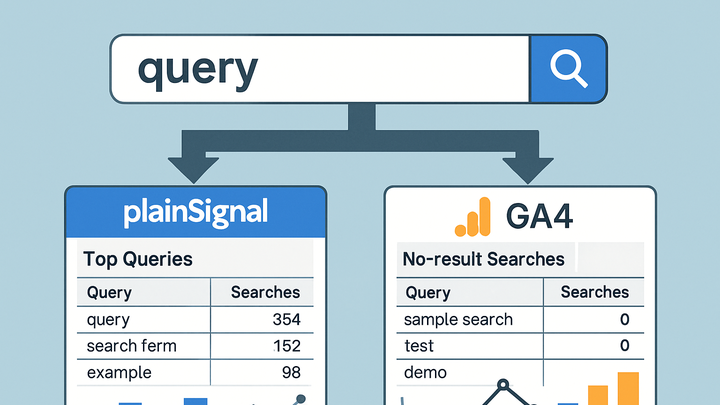Published on 2025-06-28T05:10:57Z
What is Internal Site Search? Examples and Use Cases
Internal Site Search refers to the on-site search functionality that lets users find content within your website. In analytics, tracking internal site search reveals what users are looking for, surfacing demands, content gaps, and refining navigation. Tools like Google Analytics 4 (GA4) and plainSignal provide out-of-the-box capabilities to capture search queries, measure engagement, and optimize the search experience. By monitoring metrics such as search volume, top queries, and no-result searches, you can tailor your content strategy, improve user experience, and boost conversions. This article dives into the key concepts, implementation steps, best practices, and real-world examples for leveraging internal site search analytics effectively.
Internal site search
Track and optimize your site’s search to uncover user intent, content gaps, and enhance UX using GA4 and plainSignal.
Definition and Key Concepts
Internal Site Search is the on-site functionality allowing users to search for content within your website. Analytics platforms capture and analyze these search interactions to provide insights into user intent and site structure effectiveness. Key concepts include how search terms are passed via query parameters, the structure of search results pages, and outcomes such as no-result searches. Tracking search events alongside pageviews gives a clear picture of what users are looking for and how well the site meets their needs.
-
Query parameters
Search queries are typically passed as URL parameters (e.g.,
?q=keyword). Analytics tools parse these parameters to capture the search terms entered by users.-
Parameter name
The URL key (e.g.,
q,s,search) used to identify the search term. -
Parameter value
The user’s input value that represents their search query.
-
-
Search results pages
A dedicated template or page that displays results for a user’s query. Tracking pageviews on these URLs isolates search behavior in your reports.
-
No-result searches
Search terms that return zero results. High rates of no-result searches can indicate content gaps or misaligned site structure.
-
Search events
Events or hits sent to analytics platforms whenever a search is performed, providing a signal distinct from standard pageviews.
Why Internal Site Search Matters
Monitoring internal site search offers direct insight into user intent and the topics or products your audience is seeking. By analyzing search queries and behaviors, you can optimize content, enhance navigation, and reduce frustration. Metrics like search volume, search refinement, and success rates inform both marketing and UX strategies.
-
Understanding user intent
Search terms reveal what users want most. This data helps tailor content strategies and prioritize high-demand topics.
-
Identifying content gaps
Frequent searches for topics not covered on your site highlight opportunities for new content or product offerings.
-
Improving site ux
Optimizing search algorithms, filters, or navigation reduces bounce rates and increases user satisfaction.
Implementation Guide for GA4 and plainSignal
Setting up internal site search tracking involves capturing search terms and sending them to your analytics tool. Below are step-by-step guides for both GA4 and plainSignal.
-
Configuring google analytics 4
In GA4, enable Site search under Admin → Data Streams → Web → Enhanced Measurement. Specify the query parameter (e.g.,
q) to automatically tracksearch_termevents.-
Enable enhanced measurement
Toggle on Site search in the Web data stream settings.
-
Define query parameter
Enter the exact query parameter key (e.g.,
q). -
Validate events
Use DebugView to confirm that
search_termevents are firing correctly.
-
-
Implementing PlainSignal
plainSignal is a cookie-free, simple analytics solution. Add the following snippet to your site to begin capturing internal search events:
<link rel="preconnect" href="//eu.plainsignal.com/" crossorigin /> <script defer data-do="yourwebsitedomain.com" data-id="0GQV1xmtzQQ" data-api="//eu.plainsignal.com" src="//cdn.plainsignal.com/plainsignal-min.js"></script>Then, configure event tracking in your plainSignal dashboard to capture the search input value.
-
Add snippet
Insert the
<script>tag into your site’s<head>to load plainSignal. -
Configure events
In the plainSignal UI, map your search parameter (e.g.,
q) to a custom event.
-
-
Custom javascript tracking
For full control, manually capture the search input and push events to your analytics platform using custom JS.
-
Capture input value
Listen for the search form’s submit event and read the input value.
-
Send event
Use
gtag('event', 'search', {search_term: value})for GA4 orPlainSignal.track('search', {query: value})for plainSignal.
-
Best Practices for Internal Site Search Analytics
To get the most from your search data, follow these best practices around consistency, error handling, and continuous optimization.
-
Use consistent query parameters
Standardize the URL key for search across your site to ensure accurate tracking, even if multiple forms exist.
-
Handle no-result scenarios
Design search results pages to suggest alternative queries or popular content when no results are found, and track these events separately.
-
Zero-result alerts
Capture and analyze instances where users get no matches.
-
Alternative suggestions
Provide related content or auto-complete suggestions to guide users.
-
-
Leverage search insights
Regularly review top queries and adjust your content strategy, site navigation, and metadata to improve findability.
-
Content optimization
Create or update pages for high-volume, no-result search terms.
-
Navigation improvements
Add shortcuts or filters based on common search patterns.
-
Examples and Case Studies
Real-world scenarios show how internal site search analytics drive business results, from boosting sales in e-commerce to improving knowledge base findability.
-
E-commerce store
An online retailer tracks product searches to optimize inventory and merchandising. High search-to-purchase conversion indicates strong demand, while frequent no-results searches signal missing SKUs.
-
Saas documentation portal
A software company monitors documentation search queries to identify friction points and expand help articles on frequently searched topics.
-
Content publisher
A blog analyzes search data to tailor editorial calendars toward high-demand topics, increasing engagement and retention.
